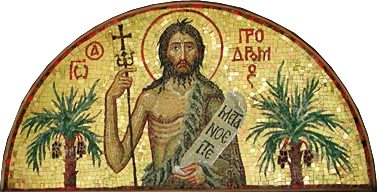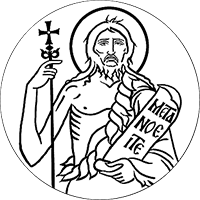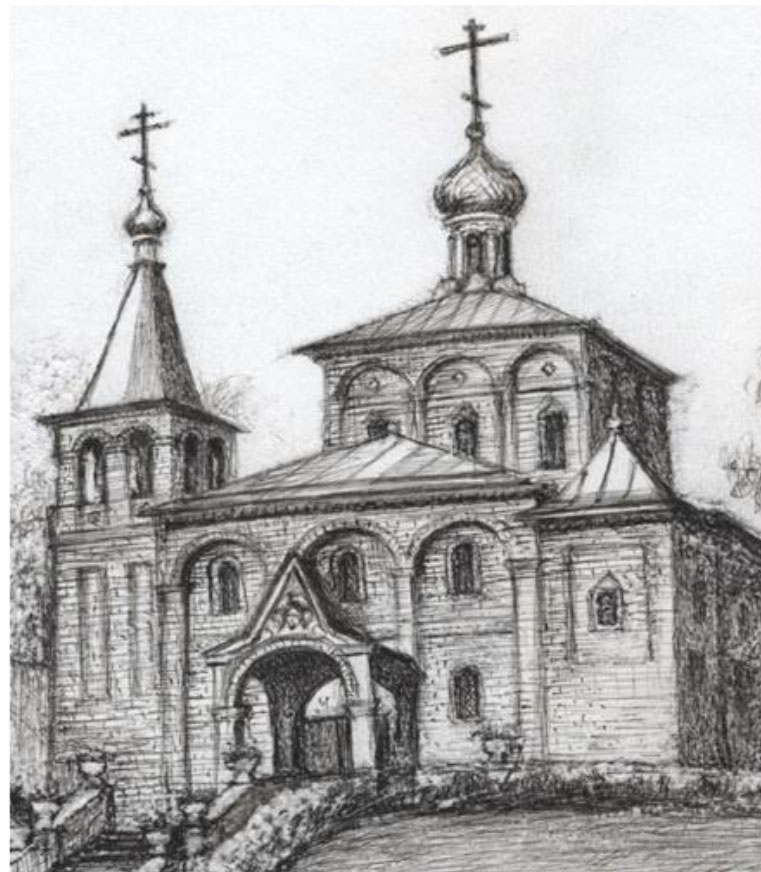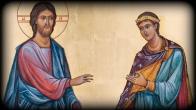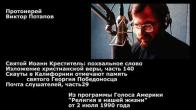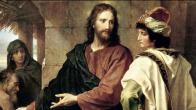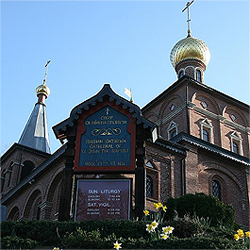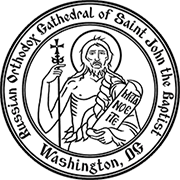You are here
SAINT SILOUAN THE ATHONITE
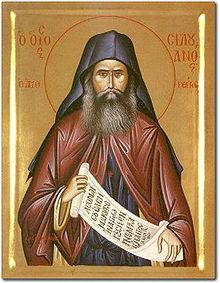
"Rejoice, O father Silouan, inextinguishable burning of love in thy prayer for the world!"
(From the akathist hymn to St. Silouan of Athos)
God's chosen one, conquering the hearts of academics and students, housewives and AI professionals, theologians and church neophytes... Today he is known to the entire Orthodox world. Human souls humble themselves before his holiness, forgetting everything earthly and becoming filled with peace, joy and prayer. The simplicity of his communion with the Lord and his evangelical, child-like faith touch hearts. Behind it, however, there is a half-century's worth of ascetic labour.

Russian St. Panteleimon Monastery on Mount Athos
Childhood and Youth of St. Silouan
The Venerable Silouan of Athos, a new witness for God and a true man of prayer for the whole world, "who in the twentieth century glorified Mount Athos and showed in it an angelic life" was born in Russia in 1866. He was born into the family of the peasant Ivan Antonov who lived in the village of Shovskoe in Lebedyansky district of Tambov province. The family was large: father, mother, five sons and two daughters. The baby was baptised in the village church of the Nativity of Christ and named Simeon.
Simeon's parents were engaged in hard peasant labour, but their life was relatively secure. They were hospitable and often provided food and shelter to those in need. From infancy, Simeon was brought up in the Orthodox faith.


House in the village of Shovskoe, owned by the family of St. Silouan the Athonite
Already as a schema monk on the Holy Mount Athos, Silouan used to recall how pious a man his father was: "I have never achieved the measure of my father. He was completely illiterate, yet he was a meek and wise man. I wish I could have an Elder like him; he was never irritated and always had a calm attitude."
Simeon did not have the opportunity to study much: after only two years of school, he began to help the family with household chores. He grew up and became a strong and physically fit man.
Feeling a burning love for God, Simeon began to pray fervently and with tears. Soon he decided to become a monk. However, he postponed his decision to go to the Kiev-Pechersk Lavra, not daring to disobey his father, who told him to complete his military service first.

Royal Life Guards Sapper Battalion in the construction of fortifications
Simeon served in the Royal Life Guards Sapper Battalion under the command of General Serebryakov in St. Petersburg. In the army, everyone loved Simeon as a diligent soldier. He was of a quiet nature and good conduct, and his comrades knew him as a loyal friend.
At the end of the military service, the future Saint went to the righteous John of Kronstadt for a blessing to go to Mount Athos. Unable to speak with Father John in person, Simeon left him a note. It said, “Father, I desire to become a monk; pray that the world does not delay me.” After the army service, Simeon stayed at home for only one week and went to the Holy Mountain.

Righteous John of Kronstadt
On Holy Mount Athos
In the autumn of 1892, Simeon Ivanovich Antonov arrived at Mount Athos. He was greeted by the large and small crosses crowning the green domes of the bell tower, churches and roofs of the Russian Monastery of St. Panteleimon, "a place of stillness, mystery and asceticism" and a witness to the high ascetic deeds of souls striving for God. This is where Simeon began his path as a novice. He later wrote, “Believing in God is one thing, knowing Him is another.”


Russian St. Panteleimon Monastery on Mount Athos
At that time, St. Panteleimon's monastery on Mount Athos had about two thousand inhabitants. At the end of the 19th century, there were five large and thirteen small churches there. All the numerous monastery buildings and outbuildings practically formed an entire city.

Brethren of the Russian St. Panteleimon Monastery on Athos, late 19th century
First Obedience and Appearance of the Saviour
Hundreds of pilgrims were constantly arriving from Russia and spending long periods of time in monastic hotels. This gave the novices plenty of work to do. Simeon's first labour obedience was work at the monastery mill.


The mill where Elder Silouan worked
The novice Simeon spent entire days alone, carrying fifty-kilogram sacks to the third floor of the mill and pouring grain into the millstones.

St. Elijah's Church "on the Millstones"
Here, during vespers in the mill Church of the Holy Prophet Elijah, to the right of the holy doors, where the icon of the Saviour is located, the novice saw the living Christ. The Lord miraculously appeared to the young novice, filling his whole being and his very body with fiery grace of the Holy Spirit. At that moment, Simeon was made aware with all his being that his sins were forgiven.
After that, a new stage began in the spiritual life of the young novice Simeon. The surrounding world was magnificent, the people were pleasant, and nature was inexpressibly beautiful. The body became lighter, the strength increased, the word of God was pleasing to the soul, and the nightly vigils in the church and especially the private prayers in the cell became sweet. His soul, filled with joy, felt pity for all people and prayed for the whole world.
Some time after, while Brother Simeon was serving in the monastery refectory, he had a similar visitation of Divine grace. It happened in the morning on a feast day, after the all-night vigil in church.


Refectory of St. Panteleimon Monastery
The memory of what he had experienced remained, but the peace and joy in the heart were diminished and succeeded by bewilderment and fear of loss... In 1896, four years after entering the monastery, Simeon was tonsured into the small Schema with the name Silouan.

Venerable Silouan the Athonite
"Keep your mind in hell and despair not"
From the day of the Lord's appearance to him, Monk Silouan waged a fierce struggle against his passions, striving to preserve purity of mind and heart. On one of such painful nights, when, despite all his efforts, it was impossible to pray properly, Silouan, rising from his stool to bow, saw before himself a figure of a demon, standing in front of the icons and waiting for a bow to him.
Father Silouan sat on his stool again and cried out to God with anguish in his heart, “Lord, You see my desire to pray to You with a pure mind, but the demons stand in my way. Teach me, what should I do to keep them at bay?
The answer from God was, "The proud always suffer from demons."
"Lord," Silouan prayed, "teach me what must I do to humble my soul?"
Then the Lord said to him, "Keep your mind in hell and despair not."

After this revelation, Monk Silouan firmly embarked on a spiritual path. From that day on, his favourite saying was: "Soon I shall die, and my wretched soul shall descend into cramped black hell, and there I shall languish alone and cry for the Lord, "Where are You, the light of my soul? I cannot live without You."
This fiery path was not short. For fifteen years Father Silouan continued to weep in his heart, suffering as the grace of God was weakened by the swings of changing human nature. This continued until he gained the power to ward off what had previously struck him hard with a single movement of his mind, not expressed outwardly.
Solitude on the Old Mountain Rusik
As the visitations of grace grew in strength and duration, Silouan's gratitude to God also grew in his soul: "O Lord, how can I thank You for this new, inscrutable mercy: to the ignorant and to the sinner You are revealing Your mysteries. The world is perishing in the fetters of despair, and to me, the last and worst of all, You reveal eternal life. Lord, I cannot keep this to myself, let the whole world know You.”
Gradually his prayer becomes filled with sorrow for the world that does not know God. “To pray for people is to shed blood,” the Elder, taught by the Holy Spirit to love Christ, once said.

Archimandrite Misael (Sopegin), rector of St. Panteleimon Monastery in 1905–1940
"The world is still standing through prayer. When prayer falters, the world will perish," Father Silouan used to say. Seeking for silence and solitude, he besought his abbot to give him a blessing to go to the Old Rusik hermitage (Stary Rusik).
This hermitage is located in the mountains, about 250 metres above sea level, east of the Monastery and within an hour and ten minutes’ walk. The fasting routine there was stricter than in the monastery. This place was deserted and silent, which is why the monks desiring more solitude for the "noetic doing" of the Jesus Prayer sought to go there.

In the southeast of the fraternal house there still stands the now dilapidated small kaliva built by St. Silouan. It is a simple hut, now called "the monk's hut" by the Athonite monks.
According to the accounts of the Venerable's disciple, Father Sophrony (Sakharov), St. Silouan spent his time on Athos not only in prayer, but also "mowing hay, chopping trees, and preparing firewood for the winter."
In the short breaks between prayers and obedience, the Elder looked at the clouds, the sea, the mountains, the forest and any single tree with a great sense of beauty. He stopped to contemplate the visible beauty and the word of God in it.
One of the peculiarities of monastic prayer on the Holy Mountain is the vigil in the second half of the night and vigilant all-night prayer on the most important feast days. Venerable Silouan was physically strong and slept intermittently from an hour and a half to two hours a day. In 1911 he was tonsured into the great schema.


Cell of St. Silouan of Athos in the Old Rusik
Serving as a housekeeper
It is not known how long he stayed in the Old Rusik and when, with the blessing of his Elder, he returned to the coenobitic monastery. Here the Venerable Silouan was entrusted with the duties of the monastery steward. There were about 200 people under his command.
He was a man of remarkably soft heart, tender love, extraordinary sensitivity and responsiveness to all sorrow and suffering. After going around the workshops, the Elder would go to his cell to weep "for the people of God".
![]()
Icon of St. Silouan the Athonite, handwritten by sisters of St. Elisabeth Convent
The constant, deep spiritual weeping of his heart, aching for his workers, was growing to Adam's lament for the whole perishing world. "The Lord has pity on everyone," the Venerable once said, filled with the Spirit of Christ.

To the north of the Transfiguration building there were houses with cells occupied by the brethren working in the tannery, locksmith, blacksmith and other workshops located there. It is believed that St. Silouan also lived here, on the second floor. After the 1930s and until his death, the Elder worked in the monastery food store.

After the revolution of 1917 (especially in the 1920s and 1930s) the monastery experienced significant financial difficulties. Almost all of its workshops and trades, including the hospital, fell into decline. Because of the scarcity of funds and frequent illnesses the number of brethren was gradually declining. With up to 50 dying each year, the number of Russian monks on Athos eventually decreased to 215 people.
However, it was at this time that a remarkable spiritual flower blossomed in the monastery - the Venerable Silouan, who ascended to the height of dispassion and pure love for God and neighbour.


The book about Saint Silouan
In 1930, St. Silouan met the 34-year-old monk Sophrony (Sakharov) and became his spiritual father and confidant. In 1932 Father Sophrony became a hierodeacon, and in 1941 a hieromonk.
Before his death, Venerable Silouan passed on to Father Sophrony his writings, which became the basis of Father Sophrony's most famous work, the book titled Saint Silouan the Athonite.

Elder Silouan of Athos (number 1 in the photo) with the future Archimandrite Sophrony (number 3 in the photo)
The book Saint Silouan the Athonite in many respects contributed to the canonization of the Venerable Silouan of Athos in 1987-1988. Despite the small amount of information about the Saint's visible life, Father Sophrony was able to portray the spiritual image of the elder Silouan, a theologian as a witness for God and a "knower of God".
The Righteous Death of Schemamonk Silouan
Elder Siluan reposed at 2 am on September 24, 1938 in the monastery hospital. In the 1930s, the hospital room was a large hall divided in two halves by a partition.
The corners of the second, rear half, on the side of the windows facing the sea, were separated from the common space by thin walls, forming two small rooms.
Schemamonk Silouan died in one of these rooms on the ground floor, provided to him by the monastery medic Thomas, who was in charge of the hospital.
The causes and the Venerable's illness remain unknown. We know that he had already been in this hospital when one day he fell seriously ill with the flu. In the last years of his life, Elder Silouan suffered a long illness. According to Archimandrite Sophrony, he suffered from rheumatism and "excruciating headaches".
His progressing illness became apparent nine days before his death, on September 15, as the Elder was fulfilling his duties at the store. Father Sophrony, who came to visit him, saw the elder's suffering face and advised him to urgently go to the hospital. The elder objected at first, saying that there were other patients there, but when he was offered a separate room he agreed. The patient was placed in the lower ward.
From the beginning of his illness until his death, Venerable Siluan was silent, and Father Sophronius, who often visited him, did not disturb him with any questions. For the following several days, no one was trying to find out what the Elder's condition was, but as a seriously ill person, according to the monastic custom, he received Communion daily.
On Monday, September 19, the Sacrament of Unction was performed over Father Siluan. When his condition drastically deteriorated a few days later, the Elder was visited by Hieromonk Sergius who read over him the Canon to our Sweetest Lord Jesus Christ.
In a quiet and clear voice Father Silouan said that he was feeling well. After reading the canon to the Mother of God and the prayer for the dying, the fathers said goodbye until morning. The Elder calmly asked the hospital attendant who came in at midnight if matins had begun. In the hospital, it is read much faster than in the cathedral.
When, an hour and a half after the reading of Matins, Hieromonk Nicholas came to the Elder, he found him dead. “No one,” Father Sophrony writes in his book, “heard his death, not even those who lay close to him. So quietly he departed to God."

Entry in the monastery chronicle about the death of Elder Silouan
Burial of Elder Silouan
The newly deceased Elder Silouan, like all other deceased monks, was buried on the same day according to Athos custom. The funeral of the Elder, who had lived in the monastery for 46 years fulfilling important duties, was an important event in the life of the community.
After Vespers, the body was transferred to the monastery's main church of the Great Martyr and Healer Panteleimon, where the vicar, Hieromonk Justine, performed the monastic funeral service.
Then St. Silouan was carried on a stretcher to the monastery cemetery and lowered into the tomb at about 4 p.m., during the singing of the closing litany and "memory eternal". According to established custom, a gravestone was placed over the head of the deceased to protect it from damage. The body was covered with earth and a simple wooden cross was placed on the mound.
According to monastic rules, for three years the name of the deceased elder was commemorated daily during the proskomedia, and then it was included in a special commemoration book, called on Athos the Kouvaras. Such memorial books, read on funeral Saturdays, contain the names of all of the monastery's departed monks.
Also, for 40 days after the death of the Schema-monk Silouan, kolyva was blessed daily at the monastery in memory of the newly-departed. In addition, according to monastic custom, the monks read "one round of prayer beads" (ie, repeated the Jesus prayer up to 300 times) for the repose of his soul.
Glorification of St. Silouan
Evidence has been preserved that after the peaceful death of St. Silouan, miracles began to occur from his relics. The modern-day saint, Elder Silouan, sometimes called "the olive branch from the root of the Russian land," was glorified as a Venerable fifty years after his death.

Reliquary with the venerable head of St. Silouan of Athos
One can venerate the relics of the Saint in the Intercession Church of the Pantheleimon Monastery on Mount Athos. The honorable head of St. Silouan of Athos rests in a small silver reliquary on a separate analogion stand between the iconostases of the Intercession and Alexander Nevsky churches. On the open lid of the ark there is an image of an elder praying to the Lord.

September 24, the day of the Saint's repose, is now celebrated at St. Panteleimon Monastery as a panigiri (one of the monastery's main feasts). A solemn all-night vigil is performed, lasting about 10 hours.

It usually begins on the previous evening and ends at dawn. Liturgy is served both in the Intercession Church and the paraklesis of St. Silouan of Athos, consecrated in 2000 and located in the old mill where he fulfilled his first duties.
Letters come to Panteleimon Monastery at all times, testifying to the heavenly patronage of St. Silouan for all those who turn to him in prayer.


O Venerable Father Silouan, now you live in heaven and see the Lord, whom your soul has come to love while you were still on earth. We ask you to pray for us, so that we too may love the Lord and bring repentance, in which He is pleased. Amen.
Original article presented by obitel-minsk.ru
Photos from open sources
September 20, 2022
PARISH LIFE
RECENT VIDEOS
Address of our Cathedral
Subscribe to our mailing list
While all the materials on this site are copyrighted, you may use them freely as long as you treat them
with respect and provide attribution on the Russian Orthodox Cathedral of St.John the Baptist of Washington DC.
